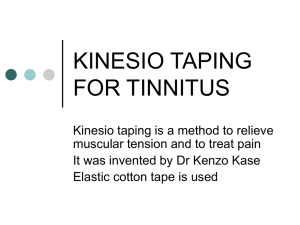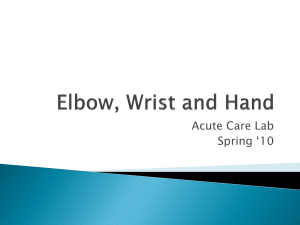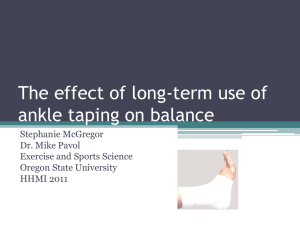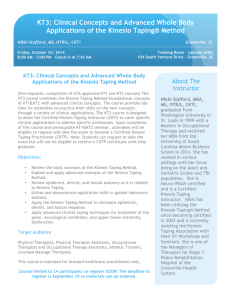File
advertisement
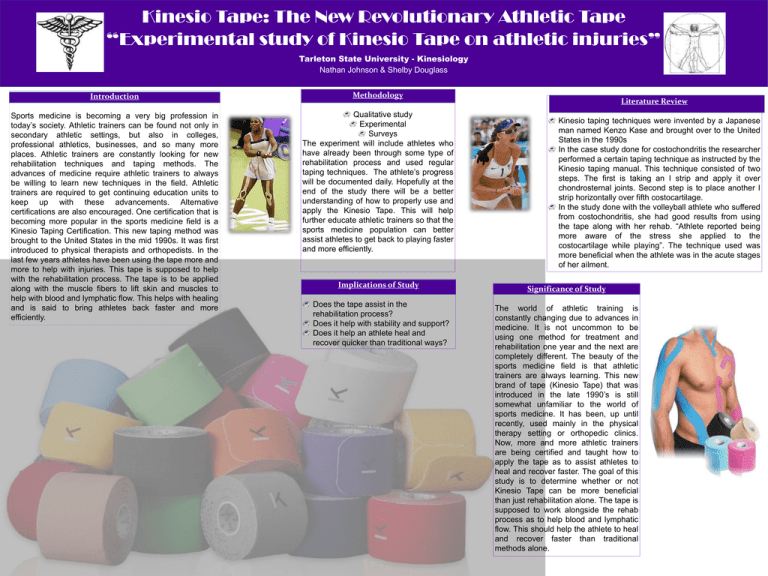
Kinesio Tape: The New Revolutionary Athletic Tape “Experimental study of Kinesio Tape on athletic injuries” Tarleton State University - Kinesiology Nathan Johnson & Shelby Douglass Introduction Methodology Sports medicine is becoming a very big profession in today’s society. Athletic trainers can be found not only in secondary athletic settings, but also in colleges, professional athletics, businesses, and so many more places. Athletic trainers are constantly looking for new rehabilitation techniques and taping methods. The advances of medicine require athletic trainers to always be willing to learn new techniques in the field. Athletic trainers are required to get continuing education units to keep up with these advancements. Alternative certifications are also encouraged. One certification that is becoming more popular in the sports medicine field is a Kinesio Taping Certification. This new taping method was brought to the United States in the mid 1990s. It was first introduced to physical therapists and orthopedists. In the last few years athletes have been using the tape more and more to help with injuries. This tape is supposed to help with the rehabilitation process. The tape is to be applied along with the muscle fibers to lift skin and muscles to help with blood and lymphatic flow. This helps with healing and is said to bring athletes back faster and more efficiently. Qualitative study Experimental Surveys The experiment will include athletes who have already been through some type of rehabilitation process and used regular taping techniques. The athlete’s progress will be documented daily. Hopefully at the end of the study there will be a better understanding of how to properly use and apply the Kinesio Tape. This will help further educate athletic trainers so that the sports medicine population can better assist athletes to get back to playing faster and more efficiently. Implications of Study Does the tape assist in the rehabilitation process? Does it help with stability and support? Does it help an athlete heal and recover quicker than traditional ways? Literature Review Kinesio taping techniques were invented by a Japanese man named Kenzo Kase and brought over to the United States in the 1990s In the case study done for costochondritis the researcher performed a certain taping technique as instructed by the Kinesio taping manual. This technique consisted of two steps. The first is taking an I strip and apply it over chondrosternal joints. Second step is to place another I strip horizontally over fifth costocartilage. In the study done with the volleyball athlete who suffered from costochondritis, she had good results from using the tape along with her rehab. “Athlete reported being more aware of the stress she applied to the costocartilage while playing”. The technique used was more beneficial when the athlete was in the acute stages of her ailment. Significance of Study The world of athletic training is constantly changing due to advances in medicine. It is not uncommon to be using one method for treatment and rehabilitation one year and the next are completely different. The beauty of the sports medicine field is that athletic trainers are always learning. This new brand of tape (Kinesio Tape) that was introduced in the late 1990’s is still somewhat unfamiliar to the world of sports medicine. It has been, up until recently, used mainly in the physical therapy setting or orthopedic clinics. Now, more and more athletic trainers are being certified and taught how to apply the tape as to assist athletes to heal and recover faster. The goal of this study is to determine whether or not Kinesio Tape can be more beneficial than just rehabilitation alone. The tape is supposed to work alongside the rehab process as to help blood and lymphatic flow. This should help the athlete to heal and recover faster than traditional methods alone.


